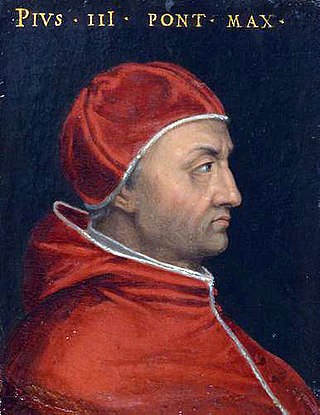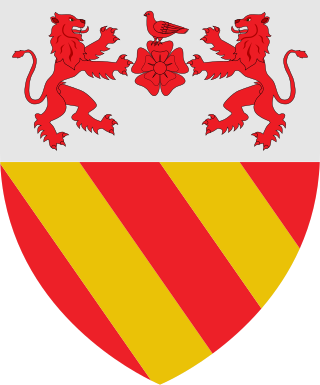Related Research Articles

The House of Colonna, also known as Sciarrillo or Sciarra, is an Italian noble family, forming part of the papal nobility. It was powerful in medieval and Renaissance Rome, supplying one pope and many other church and political leaders. The family is notable for its bitter feud with the Orsini family over influence in Rome, until it was stopped by papal bull in 1511. In 1571, the heads of both families married nieces of Pope Sixtus V. Thereafter, historians recorded that "no peace had been concluded between the princes of Christendom, in which they had not been included by name".

Pope Pius II, born Enea Silvio Bartolomeo Piccolomini, was head of the Catholic Church and ruler of the Papal States from 19 August 1458 to his death in August 1464. He was born at Corsignano in the Sienese territory of a noble but impoverished family.

Pope Pius III, born Francesco Todeschini, was head of the Catholic Church and ruler of the Papal States from 22 September 1503 to his death. At just twenty-six days, he had one of the shortest pontificates in papal history.

Ferdinando Trastámara d'Aragona, of the Naples branch, universally known as Ferrante and also called by his contemporaries Don Ferrando and Don Ferrante, was the only son, illegitimate, of Alfonso I of Naples. He was king of Naples from 1458 to 1494.

Muzio Attendolo Sforza, was an Italian condottiero. Founder of the Sforza dynasty, he led a Bolognese-Florentine army at the Battle of Casalecchio.

Sigismondo Pandolfo Malatesta was an Italian condottiero and nobleman, a member of the House of Malatesta and lord of Rimini and Fano from 1432. He was widely considered by his contemporaries as one of the most daring military leaders in Italy and commanded the Venetian forces in the 1465 campaign against the Ottoman Empire. He was also a poet and patron of the arts.

The House of Savelli were a rich and influential Roman aristocratic family who rose to prominence in the 13th century, the youngest is still alive today (1626–2022).

Jacopo Piccolomini-Ammannati, or Giacomo Piccolomini was an Italian Renaissance cardinal and humanist.
Gentile Virginio Orsini was an Italian condottiero and vassal of the papal throne and the Kingdom of Naples, mainly remembered as the powerful head of the Orsini family during its feud with Pope Alexander VI. Though best known as Lord of Bracciano, during his lifetime he bore many titles, among which Count of Tagliacozzo, Vicovaro and Anguillara, Lord of Cerveteri, Knight of the Order of Emellino (1463), Constable of the Kingdom of Naples and Gonfalonier of the Roman Church. The aforesaid fiefs were all confiscated in favor of the Colonna or the Borgia family during Virginio's conflict with Naples and the Pope.

Anguillara were a baronial family of Latium, especially powerful in Rome and in the current province of Viterbo during the Middle Ages and the early Renaissance.

Roberto Malatesta was an Italian condottiero, or mercenary captain, lord of Rimini, and a member of the House of Malatesta.

Everso II degli Anguillara was an Italian condottiero, a member of the Anguillara family.

Napoleone Orsini was an Italian condottiero.

The Duchy of Alvito was a fiefdom of the Kingdom of Naples, in southern Italy.
Prospero Colonna was a cardinal-nephew of Pope Martin V, whose election ended the Western Schism. Colonna was excommunicated for a period due to his rebellion against Martin V's successor, Pope Eugene IV, becoming one of the few excommunicated cardinals. Despite this, Colonna was the leading candidate to succeed Eugene IV in the papal conclave, 1447, where he was two votes away from election for the first three days.

Skanderbeg's Italian expedition (1460–1462) was undertaken to aid his ally Ferdinand I of Naples, whose rulership was threatened by the Angevin Dynasty. Gjergj Kastrioti Skanderbeg was the ruler of Albania who had been leading a rebellion against the Ottoman Empire since 1443 and allied himself with several European monarchs in order to consolidate his domains. In 1458, Alfonso V of Aragon, ruler of Sicily and Naples and Skanderbeg's most important ally, died, leaving his illegitimate son, Ferdinand, on the Neapolitan throne; René d'Anjou, the French Duke of Anjou, laid claim to the throne. The conflict between René's and Ferdinand's supporters soon erupted into a civil war. Pope Calixtus III, of Spanish background himself, could do little to secure Ferdinand, so he turned to Skanderbeg for aid.
Federico Savelli was an Italian military commander who fought in the Thirty Years' War.
The Duchy of Bracciano was a fief of the Papal States, centred on lago di Bracciano and the town of Bracciano itself and ruled by a branch of the Orsini family with the title of Lord and Duke (1560–1696).

Paolo Savelli was an Italian condottiero who served under Alberico da Barbiano in the Papal States and the Kingdom of Naples, before entering the service of the Duchy of Milan in its wars with Florence. He finally served the Republic of Venice as its commander-in-chief during the War of Padua, dying of the plague during the final siege of Padua.
References
- Pastor, Ludwig, The History of the Popes: From the Close of the Middle Ages (1906) vol. I, p 106ff. This account follows Pastor.